October 6 - 12, 2013: Issue 131
Brush-turkey – Australian Urban Bird
Brush- turkeys or Bush Turkeys (Alectura lathami) as they are sometimes called, belong to the megapodes family, meaning that they are incubator birds or mound-builders, and build large nests in which to incubate their eggs; the heat generated, like in compost bins, from these mounds of leaves is what incubates the eggs. The males build the nests.
Their name megapode literally means "large foot" (Greek: mega = large, poda = foot), and is a reference to the heavy legs and feet typical of these terrestrial birds. Several females will lay their eggs in the one mound (up to 30 eggs can be there although the average is 18-24) and the chicks are unusual among birds as they will hatch fully feathered and be able to fly within a few hours – a good thing as these birds are ground dwellers or not predisposed to flying for long times, although they can. They are able to run fast and jump over fences quite easily. Lyre birds are also ground dwellers.
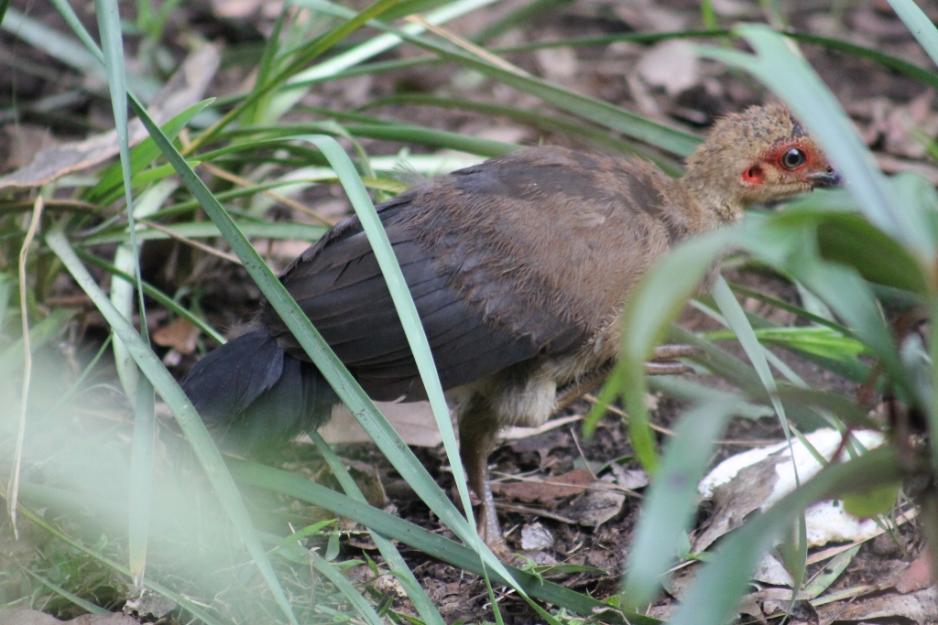
A young Brush-turkey that was scratching around in our backyard last year at this time.
Megapodes are medium-sized to large terrestrial birds with large legs and feet with sharp claws. They range from 28 to 70 cm. The largest members of the clade are the species of Alectura and Talegalla. The smallest are the Micronesian Scrubfowl (Megapodius laperouse) and the Moluccan Scrubfowl (Eulipoa wallacei). They have small heads, short beaks, and rounded and large wings. Megapodes are found in the broader Australasian region, including islands in the western Pacific, Australia, New Guinea, and the islands of Indonesia east of the Wallace Line, but also the Andaman and Nicobar Islands in the Bay of Bengal. The distribution of the family has contracted in the Pacific with the arrival of humans, and a number of island groups such as Fiji, Tonga, and New Caledonia have lost many or all of their species.
Brush-turkeys or Bush turkeys are the largest of Australia's three megapodes. the other two found here are the smaller (45 cm) Orange-footed Scrubfowl, Megapodius freycinet, which shares part of the Australian Brush-turkey's northern range, is entirely dark grey to brown, with the exception of bright orange legs and feet and the Malleefowl, Leipoa ocellata, a largely brown bird, barred with black, white and rufous. It is found in southern and south-western Australia. They are part of the family of fowl-like bird (chickens-Order Galliformes), and this includes quails, turkeys, peafowl and junglefowl.
They are called ‘wee-lah’ by the Indigenous peoples of the Hunter Region and many of our original custodians used to eat the easily gathered eggs. These birds will themselves feed on insects, seeds and fallen fruits exposed by raking the leaf litter or breaking open rotten logs with their large feet.
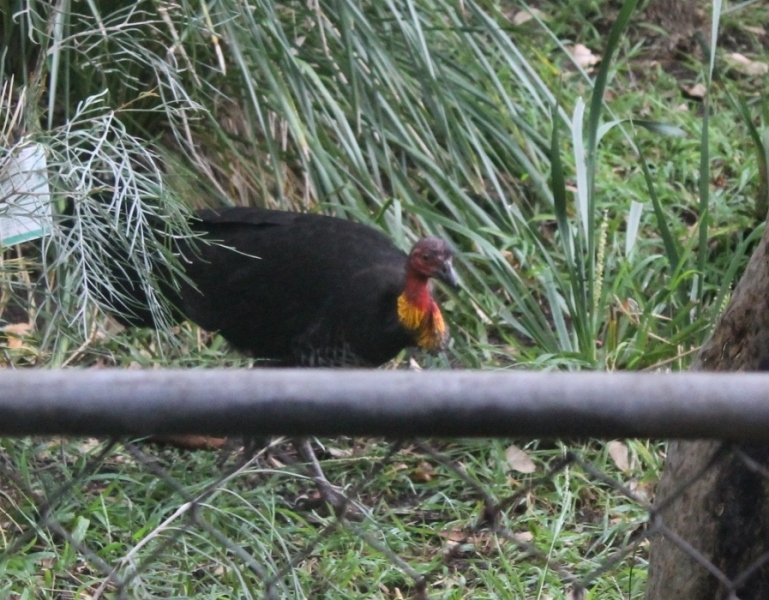
Brush Turkey in our backyard Friday afternoon again (11.10.2013) - perhaps the same fully grown bid as above.
Colonists new to Australia also learnt to raid these nests for food:
BRUSH TURKEY. As a matter of fact Mr. M'Cooey dislikes contradiction, and owing to his unkind replies to various contributors on the iguana and other questions, few persons care about trespassing upon the domain of the Australian naturaist. Notwithstanding this,it behoves all persons, in the interests of science, who read essays which come within their province, to give a mild denial to a palpable absurdity. From a gentleman who has traversed so much of this colony, one would not expect to be Horace Grooly'd with that old tradition about brush turkeys laying from sixty to seventy eggs in one nest ; and ina future issue I shall expects Mr. M'Coooy to give some tangible reasons for his bold assertion. I have robbed brush turkeys' nests in various parts of this colony, including the Gunnedah and Bog-gabri districts, also the runs Bellyena, Killarney, Edgeroi, Berrigal, Terri-hie-hie, Slaughter-house Creek, Bogamildi, and thence until they disappear towards the banks of the Macintyre River. This comprises no mean scope of country ; and yet in only one instance have I found fifteen, and in no instance have I found more than four, fresh eggs in one nest. Witness the nest built by two birds within a few yards of the Bogamildi head station; it was the usual size, and contained eight eggs. Again, the birds do not lay promiscuously as stated; far from it, they deposit their eggs in the most systematic manner, each one being end on, or perpendicular, and by all appearances having a certain amount of space allotted to it. This then might load up to the ques-tion, will a nest hatch only a certain number of eggs? This I shall answer in a future letter, giving also many interesting facts, not from books, not from hearsay, but from years of close observation, either shooting, or with a rake in my hand pulling their nests to pieces. I might here add that as the egg approaches maturity; so the earth appears to make room, until a day or two before the chick is hatched there is space between the shell and the earth large enough to admit the finger. If Mr. M'Coooy has taken sixty or seventy eggs from one nest, then, indeed, have his researches been rewarded. Trusting you will find space for those remarks in your valuable columns. —Yours, &c., Quirindi, March 1. JAMES FREDERICK. BRUSH TURKEY. (1886, March 13). Australian Town and Country Journal (NSW : 1870 - 1907), p. 29. Retrieved from http://nla.gov.au/nla.news-article71074486
So many of our native birds that were ground dwellers were hunted during our first hundred years that laws were made to protect them from hunters:
The close season under the New Birds Protection Act began on Tuesday, and will continue till the end of January. The following birds, in addition to those which are absolutely protected for a period of five years, are included in the schedule :—Brush turkey, mallee hen, land curlew, bittern, land rail, black swan, bustard or plains turkey, wild ducks and geese of every species, plovers of every species, pigeons and doves of every species, dollar birds, wood swallows, magpies(other than the black), peewit, thrush, wag-tail, jackey winter, robins, blue wren, emu wren, larks, diamond sparrow, gang-gang cockatoo, Indian minah, butcher bird, coach whip bird, honey sucker, mocking bird, swamp pheasant, king parrot, ibis, and the bird commonly known as " the happy family" or" the twelve apostles." The close season for quail begins on 1st October and ends 31st March. ITEMS OF INTEREST. (1893, August 3). The Maitland Mercury & Hunter River General Advertiser (NSW : 1843 - 1893), p. 6. Retrieved from http://nla.gov.au/nla.news-article19025257
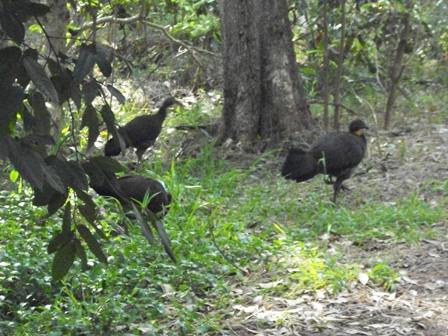 Brush-turkey colonies are common in the urban environment and we have seen one group of three strolling beside Careel Creek last year although they are meant to be fairly solitary birds. Mostly they live in rainforests and wet schlerophyll forests, but can also be found in drier scrubs. In the northern part of its range, the Australian Brush-turkey is most common at higher altitudes, and will move to the lowland areas in winter months. In the south they are common in both mountain and lowland regions.
Brush-turkey colonies are common in the urban environment and we have seen one group of three strolling beside Careel Creek last year although they are meant to be fairly solitary birds. Mostly they live in rainforests and wet schlerophyll forests, but can also be found in drier scrubs. In the northern part of its range, the Australian Brush-turkey is most common at higher altitudes, and will move to the lowland areas in winter months. In the south they are common in both mountain and lowland regions.
Brush turkeys are protected by law and as with all our birds which may become tame through feeding them, it is also illegal to feed our native birds. Creating areas where they can visit your garden by introducing native plants or replacing those that are not with bird attracting foliage that will shed seeds I season, or in the case of the Brush-turkey, creating a mud of compost in a shady corner they may then make their nest, will let you see these magnificent creatures stroll through your mornings and afternoons.
Unless it is a nest guarded by a dad Brush-turkey, they can be quite shy so if you want to watch them, just be a little bit kind and stand quietly so you don’t make them anxious with noise or sudden movements.
A children’s story from years ago about why these big birds build mounds for their eggs:
Another wonderful story 13 about how the brush turkey learned to build the odd kind of a nest that it makes. The laughing-jackass and the turtle were married, and when Mrs. Turtle went' to lay her eggs in the sand the bush turkeys saw her, and they resolved to try the same trick, and it succeeded, too, and that is how the Mound Builders came to learn tho trick of letting the sun hatch their eggs. Our Book Review. (1899, January 10). The Sydney Stock and Station Journal (NSW : 1896 - 1924), p. 3. Retrieved from http://nla.gov.au/nla.news-article120762889
References:
BirdLife Australia
Birds of the Australian Rainforests.
Handbook of Australian, New Zealand and Antarctic Birds, Volume 2 (Raptors to Lapwings).
The Atlas of Australian Birds.
BRUSH TURKEY Melbourne Family Life Story. The last of Mr. and Mrs. Brush Turkey's family has dug its way out of its nest at the Melbourne Zoological Gardens. It flew to the nearest tree, but the parents showed little interest in the youngster's feat. Explaining how tile brush turkeys, natives of Queensland, prepared for their offspring, the Director of the Zoological Gardens (Mr. Wilkie) said the male bird gathered the fallen leaves from a the silky, oak. Forming a pile about 6ft. wide and 4ft. high on the ground, it added soil and debris from trees and tramped, them into a conical shape. During this procedure the hen looked on with great interest, but only front a distance. She know she was not permitted to interfere with the male in his preparations. W\hen the nest was completed the hen burrowed into the cone and laid her eggs with the wide end uppermost. After the last egg was laid the male bird again tramped the nest. Within several days the egg, being heavy, gradually sank in the soft material. This allowed space for the chicken to move his head after he had pocked his way from the shell. If rain fell during incubation the male bird carefully threw the dry material from the base of the nest to the top. The chicks were hatched fully fledged, quite independent and able to light their own battles. The arrival of the brush turkey chicks during the past few days was the first at the Zoo for nine years, said Mr. Wilkie. "Apart from the mallee hen which scoops a hole in the sand and then covers the eggs," said Mr. Wilkie, "the brush turkey is the only bird to use a natural incubator for hatching its young." BRUSH TURKEY. (1935, January 15). Examiner (Launceston, Tas. : 1900 - 1954), p. 4 Edition: DAILY. Retrieved from http://nla.gov.au/nla.news-article51915590
TARONGA PARK (Taronga being aboriginal for Sea View) was officially opened in 1916, but long before this the public had been admitted on payment of a small fee, to stop them from admitting themselves for nothing. the ZOO NOT TOO LOGICAL GARDENS. (1946, May 21). The Sydney Morning Herald (NSW : 1842 - 1954), p. 2 Supplement: The Sydney Morning Herald Magazine.. Retrieved from http://nla.gov.au/nla.news-article17987690
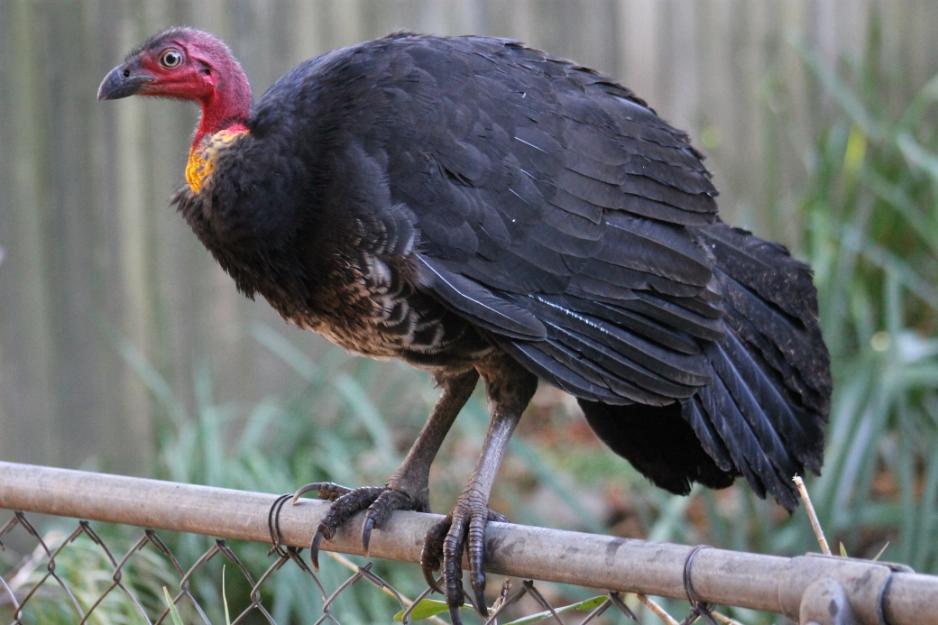
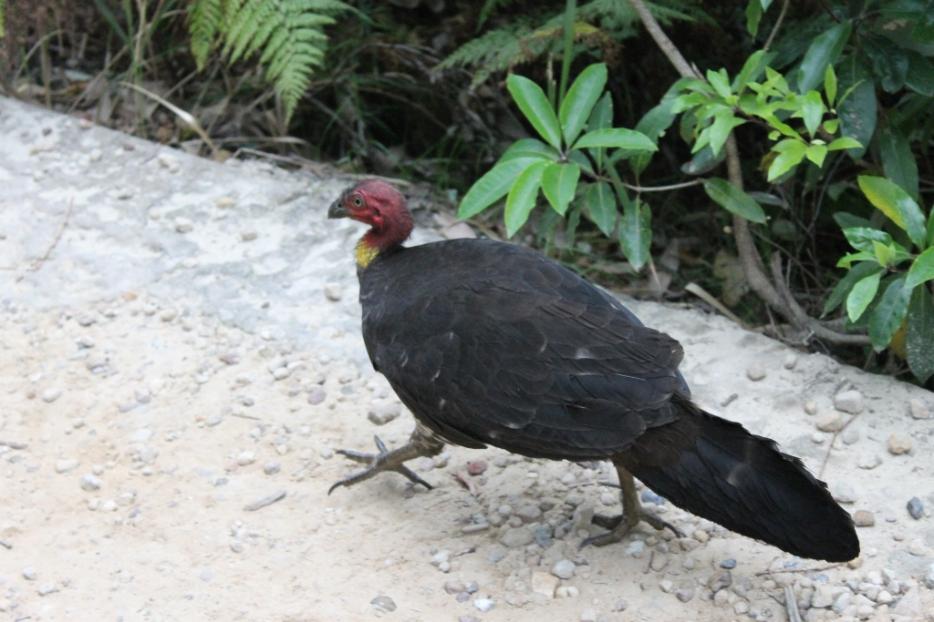
Brush-turkey (Alectura lathami) at Barrenjoey last Spring.
Photos by A J Guesdon 2012 - 2013.